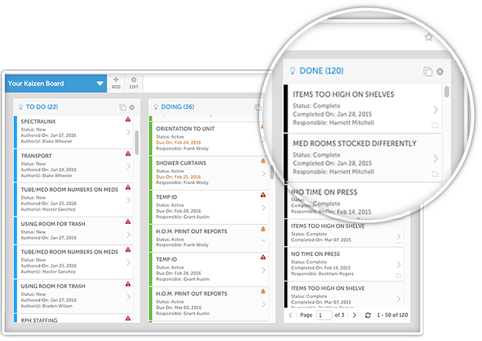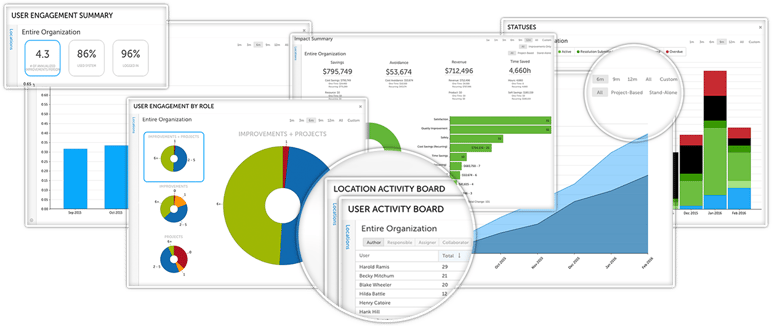Idea boards have been used for quite some time now as a way to engage staff in continuous improvement. They're an excellent improvement on a suggestion box system, since the boxes have (on average) just a 2% implementation rate. Idea boards are used in companies around the world in every industry, with varying levels of results.
In this post, we'll look at the value idea boards bring to the table, and how to improve upon them with the use of new technology.
What are some benefits of idea boards?
- Inspiring Engagement
When you have a board filled with opportunities for improvement submitted by your front line staff, the result organizations want is increased engagement in the improvement culture and enthusiasm for getting involved. Seeing those ideas - and the effort going into implementing them - inspires people to come with their own ideas, and it makes improvement part of the daily conversation. - Sharing Ideas
Humans are wired to improve. We want to do things to improve the goods and services we provide to our customers and patients, and we want to make our own jobs better, safer, and more efficient. Idea boards extend the usefulness of each improvement we make by sharing them with other people in our work area. Say, for example, that you determine it would be more efficient to store supplies in a new location. Rather than just moving them in your own work space, you can share the idea on an idea board and thus bring it to the attention of everyone else in the area. In this way, your own incremental improvement has a much larger impact on the organization. - Tracking the Progress of Improvements
The problem with a suggestion box is that the ideas are dropped in and often never brought up again. Or, they too often get rejected by some far-off committee. With an idea board, people can see their ideas flow (or not flow) through the columns, from New to In Progress to Implemented, building confidence in the improvement culture, establishing a sense of accountability, and making it easy to check on the status of ideas as they flow through the improvement cycle. - Encouraging Conversation
One of the best results of an idea board is the way that it serves as a focal point in the organization - a meeting place - around which people can congregate to share and discuss ideas. It fosters a culture of communication and collaboration in which people work together to implement the very best improvements they can. - Anyone Can Contribute
Idea boards are very democratic in that everyone is given an opportunity to make suggestions, usually looking within the scope of theireveryday jobs . No one needs to be an improvement expert or have special training to participate. They give a customer service representative the opportunity to weigh in on improving safety in the office, a sales manager a way to comment on improving office efficiency, and a developer a way to share an idea about improving new employee onboarding. The best ideas can come from anywhere, and by sharing them on a board, other people can bring fresh perspectives to the table to solve problems and make changes.
As with any improvement strategy, idea boards are only as successful as the organization's leadership behaviors and improvement methodology allow them to be. In a company with strong leadership and an effective methodology, idea boards do really well in promoting an improvement culture. Doing things like incorporating the idea board into regular discussions and empowering employees to make changes are a critical component of a successful idea board.
While idea boards are a powerful tool for improvement, given the right leadership behaviors and improvement methodology, there's software out there that can enhance their effectiveness by increasing communication in between meetings, improving visibility, and storing knowledge for the long term. Of course, we'll be the first to admit that technology is no silver bullet - and that the following enhancements to traditional idea boards aren't going to help without the proper leadership and methodology to support the improvement culture.
See it Any Time, Anywhere

Part of what makes idea boards so powerful is that they’re big, they’re beautiful, and they’re in the room with you, attracting attention and reminding people to submit ideas. The problem, though, is that that only works if - and when - you’re in the same room as them.
Continuous improvement software lets you set up your idea board just like you would on paper, but you display it on a digital screen instead. You have it hanging in the break room just like before, but it’s also accessible from anyone’s computers so that people can submit and check on their ideas without interrupting their workflow, improvement coaches can monitor progress on multiple idea boards from their desks whenever they want to, and the boards are updated in real time as ideas progress through the improvement cycle.
More Extensive Cross-Functional Collaboration

This ties back into the first idea, about how idea boards are pretty limited in who can see them. When you have separate (different) idea boards in the break room of each department, the result will be limited cross-functional collaboration. This means that when people are solving the same problem throughout the organization, they’re often solving it in parallel instead of together (because they're not aware that other areas are working on the same problems).
You’re probably aware of the value that diversity brings to an organization. People with different skills, backgrounds, and experiences will have different insights into how to solve the same problems. Continuous improvement software makes it possible to engage people from anywhere in the organization in the same idea board so that they arrive at more creative solutions more quickly.'
Of course, the goal is to get people in the same room at the same time as often as possible, sharing ideas and brainstorming solutions. Because improvement is just one part of everyone's jobs, though, the time they have for such meetings is limited. As such, improvement software is a big help in ensuring you get that cross-functional collaboration every day to compliment the less-frequent in-person meetings.
Knowledge Repository
What do you do with the note cards from your idea board (or your Trello list) after they’ve been implemented - or rejected? Hopefully you don't throw them away - but chances are, they do get filed away somewhere, whether that's in a filing cabinet or copied over into an Excel spreadsheet. Wherever you put them, it's tough to retain that institutional knowledge long-term once the idea comes down from the board.
With continuous improvement software, people can search the database to see if anyone else has solved their problem or tried some variation of their improvement. If so, they can see the steps taken and results achieved, and adjust their own change accordingly. The software is smart enough to recognize and alert people when they’re submitting a new idea that appears similar to one already in the system, cutting down on duplicate work and ensuring that each improvement has the maximum impact.
Impact, Activity, and Engagement Metrics
How do you know how many people are engaged in your improvement process when you track their ideas on a bulletin board? How do you identify bottlenecks to the improvement process, determine which areas have a rapid improvement cycle, who has had a significant impact on the organization, and who needs more coaching? All of these metrics are tough to collect when you're a small improvement team trying to manage the idea boards from around the organization. It's really hard to get accurate visibility into the impact, activity, and engagement metrics that indicate the health of your improvement culture.

Continuous improvement software automatically tracks these KPIs for you. You can see the impact of all improvement work instantly, drilling down into any level of the organization. You can put these reports on customizable boards for your executives so that they can track progress toward their strategic goals. You can see the engagement levels around the organization and identify hot spots (and cold spots) of improvement to better know where to target your coaching.
I could keep rattling off the power of these reports, but instead, I suggest you check out this free webinar to learn more.
To learn more about how improvement software enhances traditional idea boards, watch this free webinar or watch a quick video that shows the software in action.





Add a Comment